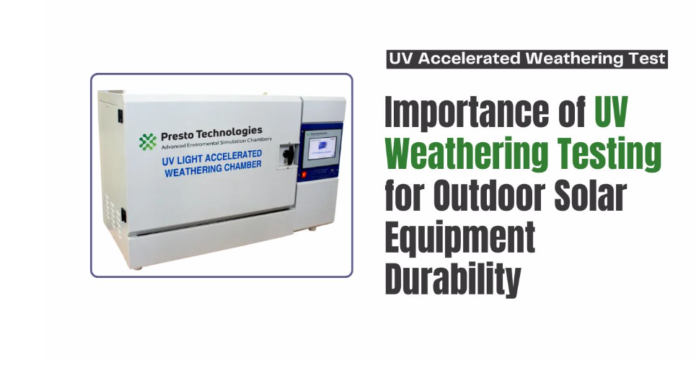In the quickly changing renewable energy industry, reliability and long lifespan of solar equipment are top concerns. Solar panels and related hardware are continually exposed to extreme environmental conditions such as high levels of ultraviolet (UV) radiation, varying temperatures, humidity, and rainfall.
These conditions can have serious effects on the equipment’s efficiency, lifespan, and structural soundness. It is here that UV accelerated weathering testers and environmental simulation chambers are most important.
The Challenge of Outdoor Exposure for Solar Equipment
Outdoor equipment like junction boxes, inverters, mounting structures, and solar panels have been exposed to direct sunlight for years. The thermal cycling, moisture, UV radiation, and other climatic conditions may lead to:
- Degradation of polymer encapsulants
- Panel surface discoloration or yellowing
- Cracking of plastic enclosures
- Mechanical failure and delamination
- Decrease in energy efficiency with time
These issues necessitate that producers test their products for long-term reliability prior to marketing them. Lacking sound testing, products can prematurely fail in the field, resulting in expensive replacements, warranty calls, and lost customer confidence.
What Is UV Accelerated Weathering Testing?
UV accelerated weathering testing is a laboratory procedure that mimics the aging effects of sunlight, heat, and humidity, especially UV radiation, in an accelerated duration. Utilizing equipment specifically designed as UV accelerated weathering testers, materials can be subjected to artificial UV light, heat, and moisture cycles by manufacturers, maintaining equivalent exposure to months or years outdoors within a matter of days or weeks.
This process is critical in determining how solar equipment and materials will operate when exposed to constant sun exposure over a long period. By accelerating aging, engineers and R&D personnel can detect areas of weakness and optimize product formulations prior to mass manufacturing.
How Environmental Simulation Chambers Support Solar Equipment Testing
An environmental simulation chamber is a simulated environment to mimic different real-world weather conditions. Such chambers can be used to simulate a mix of UV radiation, temperature, humidity, rain, and even dust to determine the performance of solar equipment in a variety of different climates—from tropical heat to dry deserts.
Used in combination with UV accelerated weathering testers, these chambers become dynamic tools that:
- Mimic actual weather conditions in detail
- Subject equipment to cyclical UV, moisture, and temperature fluctuations
- Deliver precise, reproducible test results
- Assist in conformity to global testing standards such as ASTM G154, ISO 4892, and IEC 61215
By exposing solar products to these simulated conditions, manufacturers are able to make sure the materials applied—such as coatings, polymers, and composites—are photodegradation, crack, warp, or fade-resistant.
Benefits of UV Accelerated Weathering Testing for Solar Products
- Predict Long-Term Durability
Accelerated testing provides rapid insight into the way a product will degrade after years of outdoor exposure. - Improve Material Formulations
Testing enables engineers to compare materials and determine the most UV-resistant choices. - Reduce Product Failures
Manufacturers can eliminate premature failures in the field by detecting vulnerabilities in materials or design. - Meet Industry Standards
Regulatory adherence is paramount. Accelerated testing enables manufacturers to comply with certification standards for international markets. - Gain Competitive Advantage
A long-lasting product also supports brand value and customer confidence, providing makers with a competitive edge in an over-saturated marketplace.
Real-World Applications in the Solar Industry
- Testing photovoltaic panel back sheet longevity
- Verification of performance of polymer adhesives and seals
- Assessing protective and anti-reflective coatings
- Assessing the performance of plastic enclosures for solar inverters
- Investigating material behavior in desert or high-altitude conditions
This complete testing allows manufacturers to create more durable products for residential as well as commercial solar installations.
Conclusion
In the world of renewable energy today, reliability is not negotiable. As solar installations should survive for 20–25 years or even more, manufacturers have to comprehensively test all their components thoroughly for UV and weather resistance. Accelerated weathering testers by UV and environmental simulation chambers are just the thing needed to mimic decades of exposure in a span of days to permit rapid, thorough verification of material and product performance.
For businesses looking for precision-engineered test equipment, Presto Enviro is the go-to partner. Through their latest range of UV weathering testers and environmental simulation chambers, Presto Enviro enables solar manufacturers to realize increased product reliability, longer lifespan, and more market confidence.

